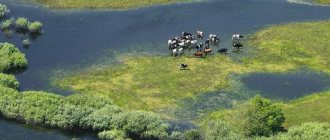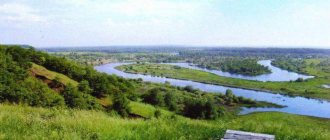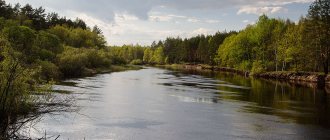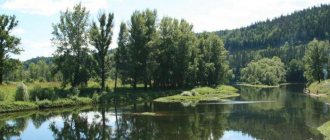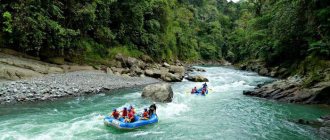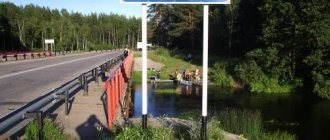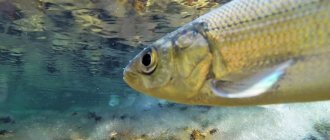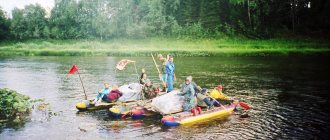Location, characteristics and main features of the Pripyat River
The Pripyat River originates in the Volyn Upland in the Lyuboml region of Ukraine. Downstream, after two hundred kilometers, it crosses the Belarusian border and continues to move along the Polesie lowland, in the Brest and Gomel regions.
- Fishing in Pripyat ↓
- Features of winter fishing ↓
- Reviews from anglers ↓
- Quick tips ↓
Note: The length of the reservoir in Belarus is five hundred kilometers.
It is characteristic that the last forty-nine kilometers of the Pripyat flow again through Ukrainian territory and flow into the Kiev Reservoir.
The main and distinctive feature of the reservoir is that the mouth is located in the exclusion zone, which arose as a result of the largest accident in the history of mankind at the Chernobyl nuclear power plant. However, the river is considered to be fairly clean in the middle and upper reaches.
Characteristics of the river:
- total length seven hundred seventy-five kilometers;
- the maximum width reaches two hundred meters, the average from fifty to seventy-five meters;
- the largest tributary of the Dnieper;
- predominantly low banks;
- winding riverbed;
- moderate, sometimes strong current;
- navigable (five hundred and ninety kilometers from the mouth);
- many rapids (especially in the lower reaches);
- mixed diet, but mostly snow;
- flood occurs in early March;
- maximum increase in water level in April;
- freezes towards the end of December;
- has many tributaries: Lan, Ila, Ubort, Goryn, Stokhod and others.
Main features of the Pripyat River:
- the most fishy in Belarus;
- flows through a picturesque area;
- sometimes there is an acceptable excess of cesium and strontium values, especially in the Chernobyl region;
- passes through radiation-contaminated areas (territory of Ukraine);
- is a key source for the transfer of radionuclides to the Kiev Reservoir.
For reference: in the thirties of the last century, most of the Polesie swamps were drained by the waters of the river.
Fishing in Pripyat
Features of fishing in Pripyat:
- home to more than thirty-five different species of fish;
- Trophy specimens are often caught;
- the opportunity to catch a very rare individual, for example, a white-eye or bluegill;
- good catch at any time of the year;
- ideal place for sport fishing;
- beautiful area;
- For those who like more comfortable fishing, there are many paid bases with different pricing policies.
You can catch:
- bream;
- perch;
- roach;
- ide;
- crucian carp;
- pike;
- carp;
- pike perch;
- soma;
- saberfish and others.
It is worth remembering that in thickets of reeds and snags it is easier to catch pike, crucian carp, and bream. The areas of maximum depth are inhabited by catfish, pike perch, and ide, while the shallow waters are predominantly inhabited by roach and perch.
On the Pripyat River in Belarus there are the most favorite fishing spots:
- Mozyr district (Gomel region): catfish, crucian carp, and perch bite especially well;
- in the vicinity of the city of Luninets (Brest region): pike, ide, roach, burbot;
- a little south of the city of Zhitkovichi (Gomel region): carp, crucian carp, catfish, roach, perch, bream.
Depending on the time of year, there are different fish activity and certain fishing characteristics.
Summer:
- you can catch almost all species;
- spinning rods and feeders are considered ideal gear;
- excellent bite on various baits, including those of plant origin;
- good weather conditions for night and morning fishing.
In the summer, it is more successful to fish:
- carp;
- silver bream;
- ide;
- bream;
- perch;
- catfish and others.
The most favorite gear during this period are feeder and spinning rod. Worms (especially dung worms), maggots, rolled oats, peas, pearl barley, corn, and often bread serve as excellent bait.
An important point: you can catch a float rod about seven meters long if the current is weak (especially bream and ide).
Note: the maximum bite is from five to ten in the morning and after seven in the evening.
Autumn:
- ideal time to catch ide;
- the probability of a large catch is slightly greater;
- in many species there is increased gluttony;
- You can often find fish in places of greatest depth.
They bite well:
- roach;
- saberfish;
- perch;
- ruff;
- burbot;
- ide.
The ideal gear at this time is spinning rods and float rods with a long rod. Much attention should be paid to the equipment; it is better to give preference to especially strong medium-sized hooks. It is better to use baits such as frogs, worms, fry.
Note: with the first snow, the probability of catching ide increases, but pike, on the contrary, is extremely difficult to catch.
Spring:
- some species are difficult to catch;
- in mid-March - early April it is extremely difficult to approach the water;
- the possibility of catching a passing individual;
- ice is especially dangerous.
Bites well:
- perch;
- pike;
- bream;
- ide;
- catfish
In the spring, spinning rods are perfect for fishing gear, but you can also use float rods. The fish bites well on bloodworms, dung worms, maggots, frogs, as well as pearl barley, dough, and bread. Predatory species can be caught using small crucian carp, spinners (especially pike), and chicken liver.
Note: catfish, silver bream, perch are more active in the daytime.
Important advice: the main thing is that the fishing lines have the largest diameter possible for the intended fish and especially strong hooks.
Fishing in Pripyat in autumn
September and the first half of October in Pripyat is a truly “toothy” period. The most attractive thing about it is the fishing of river spits, where luck often awaits both the boat and the coastal spinning fisher. During the same period, there are also plenty of other, no less attractive topics - floodplain lakes and ditches.
Not so long ago, 15-20 years ago, fishing on the spits was considered largely a summer prerogative, but in recent years this fishing has confidently flowed into September, and often into the first half of October, when underwater life is literally seething on the spits. It is on the spits that on the eve of winter, white fish fatten up and are hunted by predators, and, first of all, pike, which does not really hide, often revealing itself with violent splashes.
Features of braids
On the banks of the Pripyat, sandy shallows along which the depths gradually increase towards the center of the river have long been called spits. Roughly speaking, one bank of the spring is steep, with fairway depths adjacent to it, and the opposite is flat, shallow - this is the spit. It is important that braids are common not only for bends, but also characteristic of fairly even stretches. And somewhere in the fishing concept, almost the entire channel is made up of “braids”, for example, in a straightened section below Mozyr, where there are many places with a smooth decrease in depth from both banks, and the flow along the entire width of the river is monotonous, unhurried, and there is plenty of fish here , and very different, from ide to pike.
“Spit” is a fairly broad concept; on it you still have to calculate fishing spots in a fairly wide range of depths from a meter to three, less often deeper. More often the farthest, deepest edge of the spit works with depths of 2.5-3 m, other times, on the contrary, the coastal shallows are different.
The most attractive are spits with a sandy bottom, especially one made up of a series of dunes, the ridges of which hold food for fish and create reverse currents, and are favorite places for pike ambushes. Very interesting on the spits are all sorts of mini-pits, tubercles, and snags brought by the flood. In general, any bottom anomaly among the smooth depression of the spit is a potentially interesting place for a large pike, which, by right of the strong, takes the most profitable points for itself.
Regarding the strength of the current: pike in Pripyat do not shy away from a fast current, but it is more comfortable for them to hunt in a moderate current, which is, for the most part, present in the middle and along the far edge of the spit.
Spinning fishing from the shore
Despite all the advantages of the boat, coastal fishing on the spits is also popular in Pripyat; many people like to wander with a spinning rod along the picturesque banks of the autumn river. Long casts are usually not required; 50 m is the maximum. The bulk of bites occur 20 meters from the water's edge, so there is no particular need to fish in a wade. Often the pike chases the fry 3-5 m from the shore. True, this is mostly a medium-sized predator; respectable individuals usually stay away. In general, on the spit, with luck, you can catch a pike of absolutely any size, including a real trophy.
The tactics for fishing each point largely depend on personal preferences. Some people work the area with a wide fan, while others like to cast only downstream at an angle of 40-50 degrees, leading the bait as it slowly drifts toward the shore.
Fishing from a boat
From the boat, the spit is processed in full. The important thing here is that the boat gives you the opportunity to stand in the depths and run aground. It would seem that this is not the best option when the bait goes from shallow to deep, but for some reason bites happen precisely in this scenario. The reeling speed decreases slightly as the bait approaches the boat so that the bait continues to go closer to the bottom. Fishing section by section, I personally move the boat downstream 20-25 m. If I get a normal pike, then further fishing tactics are not at all clear-cut. There are quite dense gatherings of active predators, then serial bites are real without raising the anchor. Other times, only a single pike is caught. And most often there are several pikes that are dispersed over an area 100 meters long, and in order to catch it efficiently, you have to move the boat several times both downstream and across the river, moving either to the shallow or to the deep bank.
Lures
The favorites are tires and shakers, and the latter are in no way inferior, and often take the lead. The fishing conditions on the spit are such that the spoon is in its element: a slight current, a smooth drop in the bottom, quite shallow. There is no need for any strong “perversions” in the wiring - slow, almost uniform wiring works reliably, only sometimes it is useful to slightly change the winding speed, tug somewhere, give a mini-pause. What is definitely useful is to periodically strike the spoon along the bottom, especially if it is a sand dune - when the pike is nearby, it instantly attacks. If the water is cloudy, then I try to move the bait closer to the bottom, but when the river is clear, then I often move the bait somewhere in the middle of the water. In any case, it has long been noticed: fast retrieves work much weaker than slow, uniform ones, and if the spoon begins to plow the bottom, then it is better not to speed up the reeling, but to put a lighter bait. Along the braids, spinners weighing 14-22 g are used. Various spinners are praised. I like those that roll from side to side, this movement is clearly transmitted to the tackle, making it easy to control contact with the bottom. Some people are good at fishing with large spinners; for them, too, the conditions are most suitable.
Rubber is widely used, mainly large rippers, often light ones - white, silver, light green, yellow. For braids you will also need a supply of weights from 5 to 18 g, no more.
Practiced on streamers and trolling. By fishing wide areas with a wobbler, it is easier and faster to find areas working for pike. In addition to wobblers, large, 4-inch rubber on a jig head also works very well for trolling; for the same Narovlyan pike-makers, this is one of their favorite themes; they pull both against and with the current. Previously, trollers caught only with rippers, but now they are increasingly catching large twisters with a powerful tail. The same large, heavy spoons are also good for trolling streamers. And often on specific days on certain spits, pike prefer one type of bait. This becomes clear when partners troll with different baits, figuring out the best one. Although for me personally there is nothing better than casting on streamers, I troll, for the most part, only in company, when my friends are too lazy to throw spinning rods, then I go for a spin myself.
Time to catch
In September, the most interesting things happen from morning until lunch, then there is a break, and the evening outing is usually shorter. In October, the main pike outing usually takes place during the warmest time of the day, from 11.00 to 13.00. In general, there is a concept that for a good pike bite, the water temperature must go through a period of cooling from the summer level and stabilize for some time. In this regard, the first ten days of October usually look the best, when the water temperature “settles down” at 8-10 degrees, but not lower, and foliage begins to fly intensively from the oak trees.
The rise of water, traditional for this time of year, is extremely important and favorable in autumn fishing. Positive aspects include prolonged rains, which usually raise the water level in the river. And the autumn rise of Pripyat is always accompanied by the entry of pike into the lower reaches of tributaries and deep old rivers - Ptich, Katsurovsky Ptich (Old Ptich), Ipa, Chernotskoye, always in Shestovichi, Balazhevichi, Rokul, Zhakhovichi, Ivankov the old man, Kalinka.
Unfortunately, the low water level in recent years has led to the fact that the autumn significance of the old rivers in terms of pike fishing has decreased. At the same time, on a river in autumn, a drop in water is always bad. Even a slow decrease in level is bad. This summer, during the decline, the pike can still somehow catch, if only because it has to leave the shallow thickets of aquatic vegetation, and it is easier to find it at the edge of the thickets. Once I got into a conversation with a visiting fisherman who often fished in Pripyat, and he said about the river that before you could go to a store and just buy expensive wobblers, the same rapala, and you would be provided with fish. But such easy catches ended in the early 2000s. Back in 2006-2007, I was consistently catching catfish with a spinning rod, the banks were gorgeous, the spits were beautiful and yellow. Now, in low water, it’s not a river, but some kind of skeleton. The trees even dried out in the floodplain meadows, a sad sight. The braids became overgrown with vines, and there were few deep holes. Where should that fish stay? So fishing in Pripyat is becoming more laborious, especially for predators.
With an eye on bream
Autumn brings, one might say, an unusual phenomenon - the night feast of bream, which in its intensity and significance surpasses the summer night gatherings. We are talking, for the most part, about September and the sand spits adjacent to, or rather, looking at the spring banks. Most often this concerns bends, where the intra-turning shore gently merges with sandbanks, shaped like spits, which are feeding places for fish; and the externally turning slope is steep and reveals the presence of fairway depths, where the same bream often rests. There are more than enough such places in Pripyat. The first thing that comes to mind is the wide bend of the river near the mouth of Ptich, where there are a lot of sand spits and spring banks. Within the boundaries of Mozyr, bream is traditionally, and literally en masse, caught just below Pkhov. However, here the presence of schools of bream is, to a greater extent, associated with very dense and systematic feeding of fish, primarily by breams. Another similar, but slightly less well-fed place that holds a large number of bream on a “leash” is located in Narovlya, or so it has long been believed. In general, both in summer and in the first half of autumn, bream forests are evenly distributed along all the most accessible banks, starting from Petrikov and ending with Narovlya, or more precisely, the village of Konotop.
For pike perch
There is such an assumption at the level of conviction that in the autumn fishing for pike perch it is extremely important not to miss the period of lowering the water temperature in the range of 12-8 degrees. It is at this temperature that fanged fish are caught by almost everyone and without any whims, the main thing is that both the temperature and the water level stabilize. And sometimes the water reaches 12 degrees already at the beginning of September, although usually you need to wait for cool nights and cold rains, which are more typical for October. Speaking about general statistics, I would like to note that back in the “zero” years it was very easy to catch pike perch in Pripyat in the fall. But the catches gradually declined, reaching a minimum in 2015-2016, but in recent seasons a positive trend has begun to be seen in the catches.
Pike perch in Pripyat is caught in different ways, some by trolling, some by jig, some from the shore, some from a boat. And as practice shows, if it is caught, it is caught by almost everyone. But if some weather disasters happen, then you either need to select your key, sorting out baits and various tactics, or get to the exit time, but it is extremely unstable and usually “spread out” not by a day, but by a week. In “difficult times” it is better to fish with a group, analyzing the results; it happens that in one place a mandula will work better than rubber and foam rubber. Sometimes it’s better to walk along the path and search, especially since in the fall larger baits often work better, so the company uses both large and small wobblers at the same time. And all this can be relevant during the day.
The choice of pike perch grounds is also very difficult. Fortunately, today they are very wide. From time to time, predators are caught well in the city; it makes sense to go upstream up to Balazhevich and Petrikov; not to mention the Naravlyan direction, the same Barbarov is good. But there are no prerogatives for certain areas, as in the last century; pike perch are now distributed quite evenly among characteristic places.
In autumn, pike perch on Pripyat practically does not show itself, but it constantly intersects with pike places, primarily on the far edges of those same sand spits, which forces you to use leashes without hesitation. And while the pike, for the most part, does not care what size the bait is, then the pike perch is very picky about the size, although it also has a certain tendency - the colder it is, the larger the bait should be. Color also influences. These factors apply to both rubber and wobblers. But the fanged one is not very friendly with autumn shallows. This summer, it often rises to feed from the depths to riffles, or even to outright shallows, but in the fall it behaves completely differently, mainly sticking to depths of 3-5 m on the edges of holes.
When fishing from a boat with baits on an offset hook, fishermen must pay special attention to snags, where pike perch very often settles, at least in the area of channel holes. And now luring him out of hiding and tempting him to bite is a very interesting topic, exciting, requiring scrupulous actions, a more or less clear presentation of the underwater picture and endurance.
Today, the average weight of fish caught is about 1.5 kg, specimens weighing 3-4 kg are much less common, but 5 kg and above are already an enviable trophy.
The pikeperch season ends much earlier than many people think; no one really catches it in late autumn for a long time. But in the deep pre-winter, right up to the first edges, you can very likely find a large pike, both on the track and in the cast.
On floodplain lakes
Pripyat fishermen have an interesting topic - usually after a flood, small lakes remain on the floodplain, which by the beginning of summer are thoroughly overgrown and are practically not fished. But in the fall, in these lakes, water lilies fall to the bottom, and the predator already eats up all the fry and becomes very hungry. People usually go to such reservoirs on foot and quite successfully catch decent pike weighing 3-5 kg.
These lakes are quite small in size, can be 10 by 20 m or 30 by 60 m, and often have an elongated shape. And there are a lot of such floodplain reservoirs, starting from Konkovich to Narovlya itself. Fishing is quite intense both on the left bank and on the right bank floodplain.
Of course, this topic is in many ways purely local; it is very difficult to wander through the floodplain labyrinths even with modern gadgets. But the topic exists, and one might even say that it has been developing in recent years.
Features of winter fishing
Fishing on the Pripyat River in winter has many features:
- the likelihood of a rich catch of roach;
- good bite, despite the snow and frost;
- It is better to choose areas with weak currents;
- strong winds are often observed;
- Can be caught using artificial bait.
Bites well:
- pike;
- blue;
- perch;
- roach;
- blue-eye (rare species).
Fishing takes place from the ice. The main thing is to choose the right gear; winter fishing rods and jigs are considered the best this season. It has been noted that it is good to use silicone baits, only with a special aroma, worms, chicken liver, and predatory fish species bite well on small crucian carp and spinners.
Fishing on the Pripyat River
It's time to talk about the most important thing - the inhabitants of Pripyat and whether fishing is possible in Pripyat today.
Legally, fishing on the Pripyat River is punishable by law in accordance with certain articles of the Criminal Code of Ukraine. Recently, Ukrainian legislation has made the rules for fishing in the Exclusion Zone even stricter.
If you live in the exclusion territory, you must pay a fine. If you manage to remove any items or products from an area contaminated with radioactive nuclides, you may be imprisoned for a term of four years. If you are caught selling goods exported from the territory, you will be imprisoned for a term of 3 to 7 years.
But, in reality, all these rules are rarely followed. Fish is still caught in Pripyat and thanks to it the shadow business is thriving. People who live in the Exclusion Zone, as well as residents of neighboring areas, manage to catch fish from Pripyat and sell it. They disguise their activities as sport fishing, fishing for their own needs, etc. Moreover, for some residents of the Chernobyl zone, fishing and selling it is the only way to earn some money to live.
There is only one good thing: the fish of Pripyat today do not have such a high level of radiation as before. Over the course of thirty years, the fish was either reborn or developed immunity to radiation.
Reviews from anglers
- Alexander, Gomel “I constantly fish on the Pripyat River, and more than once I managed to catch large bream, perch, and catfish. I come in the summer and, as a rule, spend the night. In July I caught a three-kilogram pike perch on a feeder.”
- Vsevolod, Minsk “A stunning place, especially for winter fishing. We came with a large group in January, and no one left without a catch. We caught a large number of roach and pike using winter spinning rods. I bit excellently on spinners and silicone baits.”
- Mikhail, Vitebsk “In August we caught it in the Mozyr region. We were left under a great, and most importantly, pleasant impression. We fished with a feeder and float rods, and after half an hour the first perch bit on an ordinary worm. Then we managed to pull out a large ide and several bream.”
- Oleg, St. Petersburg “The most pleasing thing is fishing in Pripyat in September, when the weather is excellent and the same bite is observed. Using a spinning rod using maggots and bloodworms as bait, we caught a two-kilogram bream, several medium-sized perches and pike perch.”
- Nikolay, Rybinsk “In December, roaches were amazingly biting on jigs. Two hours later there was a rich catch, only one thing marred the fishing - a strong wind rose.”
Thus, we can conclude that on the Pripyat River fishermen can expect a good catch in any season, and the opportunity to observe an excellent bite on all kinds of bait makes the process even more exciting.
Source
Fishing Features
The Pripyat River is very popular among amateur fishermen in the region and visiting tourists. It’s worth noting right away that free fishing on the river is not possible everywhere. Significant areas of the basin and riverbed are under the control of various forms of ownership. We should not forget about the fairly strict legislation on environmental management in the Republic of Belarus. Before traveling to the Pripyat River, be sure to check the permitted periods and places for recreational fishing, as well as fishing methods. For visiting fishing tourists, it will be quite difficult to deal with various conflicts of local rules, so we strongly recommend using the services of local recreation and fishing organizers. Moreover, the specifics of the reservoir do not allow easy access to any section of the river. The lack of a developed transport network is associated with natural conditions, which is probably one of the positive factors for the favorable development of ichthyofauna. However, amateur fishing in Pripyat is very interesting and rewarding. The wide variety of species and river conditions allow for a variety of fishing methods. For catching “peaceful” fish, a variety of bottom gear, in particular a feeder, are most suitable. The most popular fishing in Pripyat is for various predators: pike perch, pike, perch, catfish and others. At the same time, we should not forget that the recreational conditions of Belarus are conducive to family vacations. This is facilitated by the magnificent nature and well-developed tourist infrastructure. For most residents of large cities, holidays on the reservoirs of the Republic of Belarus, and on Pripyat, in particular, will be filled with vivid impressions of fabulous nature, the hospitality of the owners of guest houses and bases, as well as record catches.
Fishing in Pripyat: best places
The Pripyat River flows into the Kiev Reservoir, flows through Ukraine, Russia and Belarus, and has a total length of 775 km.
Pripyat is rich in more than 35 species of fish, famous for its mild currents and beautiful scenery. Experienced fishermen or amateurs have long chosen this place as the most fruitful, so to speak “fishy” place. The most popular fishing places are the shores of Belarus. Most of Pripyat, located in Ukraine, is considered dangerous, runs along the Chernobyl nuclear power plant, and fishing is prohibited there.
- Features of fishing in Pripyat ↓
- Location and climate ↓
- What types of fish is the Pripyat River rich in? ↓
- Fishing methods in Pripyat ↓
- The best places for paid fishing ↓
- Conditions and cost of fishing ↓
- General tips ↓
- Reviews from fishermen ↓
Fishing in Pripyat: what should a fisherman expect?
Pripyat River, Chernobyl
Quiet, early morning. A wide river spreads like a mirror along the wooded bank. Here and there green water lilies float by, and a light haze covers the cool river surface like a thin blanket. And experienced fishermen have already set up camp on the shore, hoping to get a good catch from the swim. Everything would seem completely normal and not attracting attention. However, there is one “but”: this is preparing for fishing on the Pripyat River.
Catfish in the Pripyat River
Features of fishing in Pripyat
In addition to the fact that you can fish in Pripyat at any time of the year, there are a number of features that distinguish it from other bodies of water:
- It runs along the Chernobyl nuclear power plant, which means its waters are contaminated with radiation.
- The waters of this river are the main source of radionuclides that flow into the Kiev Reservoir.
- Increased levels of strontium/cesium are periodically observed due to Chernobyl.
- The reservoir flows along the picturesque landscapes that the Republic of Belarus is so rich in.
- More than 35 species of fish live here.
- It is possible to catch fish of “trophy” size.
- There is an opportunity to catch extremely rare species of fish, such as white-eye or bluegill.
- The reservoir is perfect for any type of sport fishing.
- Excellent bite all year round.
- There are excellent bases along the coast that offer their services for a fee. This is more likely for fishermen who come from afar or for people who value their own comfort above all.
Location and climate
The main part of the river is located in Polesie (Belarus), but it originates in Ukraine (Volyn). The length of the reservoir across Ukrainian territory is about 200 km, most of which is located in the exclusion zone. On Belarusian soil it flows through Polesie, Brest, and Gomel regions.
General characteristics of the reservoir:
- The length of the river is about 775 km.
- The width is about 50-75 m, and the maximum is 200.
- The Pripyat River is the largest tributary of the Dnieper.
- Low bank, muddy bottom.
- In most of the river the current is moderate, only some areas are fast.
- Navigable body of water.
- It is filled mainly due to snow melting in the spring, sometimes due to underwater springs.
- A large number of rifts/passes, mainly located near the “lower reaches”.
- Early flood (from the beginning of spring).
- Glaciation at the end of December/beginning of January.
- The maximum water level occurs in April - May.
- It has a number of large tributaries: Goryn, Stokod, Ila and others.
The climate in the area is considered moderate and characteristic of central Europe. This means that winters are relatively mild and summers are moderately hot.
What types of fish is the Pripyat River rich in?
In shallow waters, roach and perch are well caught; in the “deep” reed thickets you can catch pike, crucian carp, and bream. At the depths live pike perch, sabrefish, ide, and catfish. Pripyat is rich in the following species:
- Chekhon.
- Ide.
- Som.
- Roach.
- Crucian carp.
- Zander.
- Pike.
- Bream.
- Perch.
- Carp.
- Asp.
- Gustera and others.
Main “fishing” places:
- Gomel region, near Zhitkovichi, good fishing - crucian carp, roach, perch, bream, carp.
- Gomel region, Mozyr district – catfish, sabrefish, pike, roach, crucian carp.
- Brest region, near the village of Luninets – roach, burbot, pike, perch.
Fishing methods in Pripyat
Due to the variety of fish species, fishing occurs in different ways, but the most preferred are:
- Spinning fishing. The most popular type of fishing, you can catch perch and “average” pike with a spinning rod. If you try to go fishing on a big scale, you should stock up on a good gas engine, since the most trophy specimens live in the depths. In deep water/strong currents, you can catch large catfish, chub, pike perch, and asp.
- Feeder fishing. Usually they are caught with a feeder in the Polesie regions. Thus, they “hunt” for ide, carp, silver bream, and bream.
- Float fishing can be no less effective, the only thing is that you need to fish in shallow water, near the shore, or next to a small current, in all sorts of backwaters. Local residents prefer not to bother with “newfangled” fishing rods, but fish the old fashioned way with a float. And quite successfully! Their catch is no different from others. When fishing this way, you need to choose a fishing rod more than 5 meters long, and preferably 6-7 m.
- Trolling. Some criticize this type of fishing, saying that for success you need a good motor and a wobbler. But that's not true. This method is indispensable for fishing at great depths and in open (vast) places. Trolling will “catch” pike, which live at a depth of up to 5 meters, and carp – up to 2. It is by trolling that you can catch truly trophy specimens. It is better to choose wobblers with a size of 6 – 12 cm, with a depth of up to 5 meters.
Fishing methods
In the summer, when the water level approaches the minimum mark, it is best to fish with a feeder. Mostly bream, ide, carp and silver bream are caught on the feeder.
Also, many fishermen on the river fish with spinning rods, most often in oxbow lakes. Perch and pike are successfully caught using spinning rods.
They rarely catch fish in these places using a simple float rod, only where the current is very slow. However, many anglers using a 7 m long fishing rod get a very successful catch and a lot of emotions.
Of course, you need to think about bait. Prepare with you several types of bait from different types of cereals. Bait made from peas, rolled oats, millet, pearl barley is perfect for catching on the Pripyat River.
However, you should not cook porridge in advance, since it is a perishable product that can turn sour during the long journey to the place of catch. Dung worms and maggots are also good baits for catching fish on the Pripyat River.
The best places for paid fishing
Unfortunately, almost all fishing is paid. There are practically no free places left, and even if there are, you can’t count on a good bite there. Fishing in Pripyat is taken completely under state control, and unauthorized fishing is subject to a large fine.
There are tourist centers and fish farms along the river; you can choose the right one through a travel agency or on your own. Among the most popular paid fish farms, it is worth highlighting the following:
- JSC "Turovshchina" Another name is “Losiny Island”. The farm includes large hunting and agricultural lands, as well as 31 km of the Pripyat River. Hotels and tourist centers are located along the territory; the annual reception of guests ranges from 8-10 thousand people. The fishing industry is designed in such a way that fishing will be guaranteed. If you wish, they will show you “good” places and rent fishing rods, a boat or even a speedboat. It is possible to hire an experienced instructor who will help and give a master class on fishing. You can catch perch, burbot, pike, carp, chub, and roach.
- Torka LLC. Located on the border with the Mozyr region, it owns almost 25 km of the river. Paid private fishing is available.
- Ku PORKH "Luninets". The section of the river owned by this farm stretches from the river. Price up to river Smerd, the total area is only 9 km. Intensive fishing for industrial/personal purposes is available.
- GPU NP "Pripyatsky". The total territory occupies about 37 km, located at the central mouth of the river. Fishing for personal purposes is available.
Best places
The Pripyat is considered one of the most fishy rivers in Belarus.
Throughout the entire river, in different places and areas for catching there are their own characteristics and nuances.
The time of year plays an important role in the fishing location. In the spring, for example, it is quite difficult to find an entrance and approach to the water, since the river spreads quite strongly. The spring flood lasts for several months. In addition, in the spring it is prohibited to enter the water due to fish spawning.
However, you can try fishing near large cities. And the question of the success of the catch during this period is ambiguous. Many anglers believe that at this time the fish leave to prepare for spawning.
In the summer, when Pripyat enters its shores, fishing enthusiasts increase significantly. In autumn, Pripyat is famous for its successful pike fishing.
Since the famous Chernobyl is located in the lower reaches of the river, fishing in most suitable places is prohibited, because. there is a threat of radioactive substances entering with water and sludge. In the upper and middle reaches the river is quite clean from radiation. Therefore, it is here that fishing is in great demand and pleases fishermen, impressing with the abundance of fish.
During flood periods, the area in the upper reaches of the river is flooded and is an excellent spawning ground for fish.
The character of the landscape and river banks becomes completely different when the middle flow begins. These areas have mostly sandy shores and a hard bottom. In these places there are much more fish than in the upper reaches.
However, it is worth considering that the current itself becomes faster and you need to fish using heavier equipment. Here you can find sabrefish, ruffe, burbot, carp, catfish and other types of fish.
Places on the oxbow lakes of the Mozyr region, as well as south of the city of Luninets, are popular for fishing at any time of the year. In summer, popular places are near the village of Konkovichi, as well as in the Zhakhovichi region. In autumn, fish bite well south of Zhitkovichi. The area around Petrikov is also considered fishing spots.
They fish in Pripyat both from the shore and from a boat. Since the banks of the river are sandy and low, they are flooded during floods, forming shallow lakes. When the water recedes, the sandy shores become beaches for relaxation and fishing.
However, not all vacation spots will offer successful fishing. Many beaches are not suitable for fishing at all. The fact is that the topography of the beach bottom plays a big role. Large fish go into the depths, and small fish are found in shallow water. Since the bottom topography of the Pripyat River is heterogeneous, it is better to study the bottom for shoals or dumps before choosing a place for fishing from the shore.
Conditions and cost of fishing
Due to the increase in poaching, the government of the Republic of Belarus has tightened the rules for fishing in Pripyat. For example, 20 years ago, there were about 65 species of fish in the river, among them 20 were included in the Red Book, now 35. Of which only 2 species are included in the Red Book. In addition to paid fishing, there are a number of restrictions that make it possible to regulate the fishing of rare varieties.
Basic and mandatory fishing rules:
- It is strictly forbidden for one person to use a rod with more than 5 hooks.
- Fishing ban in the Brest/Gomel region from March 1 to May 18.
- Mogilev region from April 10 to June 8.
Amount of fines for poaching:
- Burbot – 1,350 thousand Bel. rub.
- Pike, bream, silver bream, sabrefish – 450 thousand BYN. rub.
- Carp, ide, catfish – 900 thousand BYN. rub.
Source
Fishing in Pripyat
Fishing in Pripyat: is it possible or not?
The exclusion zone is crossed by Pripyat from north to southwest. Near the Chernobyl nuclear power plant, its bed was replaced so that it would cool the power plant.
In this place, the Pripyat River widens to 400 m. On average, the depth is 3-4 meters, while there are holes up to 8 meters.
Within the exclusion zone, its length is 60 km.
The river area is a real Eldorado for fishing lovers. About 42 species of fish are found here.
The most valuable for fishermen are such river species as: crucian carp, tench, perch, bream, burbot, pike perch, pike, etc.
Important! Predatory fish species contain more radionuclides than herbivorous fish.
Important! There is the Uzh River, and in it you can catch 6 times more than in the Pripyat River, although the river itself has a lot of all sorts of tributaries and lakes.
Since there were no people in Pripyat for a long time, the river abounds in fish, which in turn attracted poachers.
It doesn’t take much effort to catch a lot of fish. During the night, a group of 4-5 people can catch up to 1 ton of fish.
Although radiation is inherent here, fishing in Pripyat is quite popular, local workers especially love it and fish purely for themselves, in clean places.
There are also fishermen-tourists who come to the exclusion zone for leisure. They are not interested in fish in the form of a trophy; they caught it, photographed it, and released it back.
Near the cooler, the pollution is higher, so there is no such fishing here, although there is an abundance of fish here and they are not shy.
This is where the famous catfish of Chernobyl are found, lazily swimming along the surface.
Most people believe that their size is due to radiation exposure. In fact, they are of normal size and the catfish itself grows throughout its entire life, and if it is not caught, it may well live up to 100 years.
Features of fishing for roach in autumn on the Pripyat River
In the second half of October, when many amateur fishermen stop visiting reservoirs and wait for freeze-up, a rather short, but very productive time begins for catching the much-loved roach. During this period, roach fishing
occurs on float, feeder and even spinning gear.
But the most popular equipment for fishing for roach in the autumn is a float rod. Those who have had the opportunity to fish in Pripyat are well aware that there are many excellent oxbow lakes there, and the deepest of these oxbow lakes in the autumn become a good temporary shelter for a large number of roach. Local fishermen determine the autumn run of roach by the condition of the maple tree. As soon as this tree begins to shed its leaves, it is time to look for autumn roach. Autumn fishing for roach
lasts about a month, and at the same time trophy-sized roaches weighing 500-700 grams are actively biting.
If you catch roach not in the oxbow lakes, but in Pripyat itself, then the best places where you can find this fish are those where there are flooded tree trunks, bushes sticking out of the water, piles from destroyed bridges, etc.
In autumn, the best roach bite occurs at dawn and, with changes in activity, lasts until noon, and then subsides. Then the bite of this fish resumes about two hours before sunset. This is especially true when the days are sunny and fine. As a rule, it is possible to catch trophy specimens immediately after dawn or just before sunset.
A little about gear for autumn fishing. Fishing for roach in autumn
has its own characteristics, without knowledge of which one cannot count on a good bite. For example, many amateurs use summer gear in the fall, and are very surprised that the fish stubbornly ignores their baits and attachments. They simply do not take into account that the external environment changes in the fall, cooling occurs in both air and water, which means that the water becomes more transparent. And the gear, which is very sensitive in the summer, is already quite rough in the fall for catching roach.
To catch roach in the fall, the tackle should be as light and thin as possible. So the diameter of the fishing line should not exceed 0.12 mm, and the float should have a weight of no more than 2 grams, and a thin antenna. As for the leash, its cross-section should be no more than 0.10 mm, and ideally 0.08 mm. Hooks should also be used small No. 3.5-4 according to the domestic classification. This type of equipment is best suited for catching roach in the fall.
For such equipment, you should select carbon fiber rods with a length of 5-6 m. It is best to use a monolithic rather than a standard tubular whip; when hooking, it has excellent shock absorption and also protects the equipment from breaking. Usually, a landing net is not needed to catch roach; when landing, even large roaches offer little resistance. What you need to have with you is a fish tank.
Of course, successful autumn roach fishing in Pripyat
, as indeed in other bodies of water, is impossible without the use of bait. However, in the fall you need much less of it than in the summer; you still shouldn’t overfeed the fish. If you decide to buy bait in a store, then you need to make sure that its packaging indicates that it is intended for winter fishing. After all, you will have to feed the roach in cold autumn water. The consistency of bait for catching roach in the fall should be loose; when it falls into the water, such bait leaves behind a noticeable trail that attracts roach.
Many fishermen prefer to prepare bait with their own hands, using the following recipe, in which some deviations from the rules are possible. For 1 kg of ground rye crackers, add 1 cup of oatmeal, semolina, ground sunflower seeds, and dry milk. Then all the ingredients are thoroughly mixed; no flavorings should be added, an exception can be made for cocoa. You can add 1 tablespoon of salt to the entire volume of the mixture. And at the reservoir, an animal component is added, bloodworms, chopped worms or maggots.
Fishing points should be fed with 2-3 balls of bait the size of a small apple. It should be taken into account that in autumn the roach will approach the bait point slowly. It may take more than half an hour before the first bite occurs. It is recommended to feed several places that you think are promising, and fish there one by one. When the bite subsides at one point, they move to another. Fishing for roach in autumn
will always be successful if you feed the right place correctly.
Baits and baits play an important role in autumn fishing. For catching autumn roach, a medium-sized maggot is best suited, and the smaller it is, the more excitedly the roach bites on such bait. Many fishermen use bloodworms for bait, however, despite the fact that the bite on such bait is always good, in most cases small roach bite. A “sandwich”, a worm and maggot, or maggot and bloodworms work well for roaches.
Local fishermen who constantly fish in Pripyat are excellent at catching roach using rye bread and believe that this is the best bait for catching roach. At the same time, trophy specimens are often caught on black bread, and not just small roach. Therefore, such a “summer” bait remains very relevant in the fall.
Autumn fishing for roach is a rather exotic activity. If the place is baited and no roach bites occur, you need to pay attention to the condition of the bait on the hook. It often happens that it is somewhat wrinkled. The thing is that in roaches the receptors responsible for taste are located deep in the oral cavity. In autumn, the fish's metabolism slows down very much, and it can hold the bait in its mouth for ten minutes or more without doing anything. It often happens that this fish simply hangs on the hook if an attempt is made to re-cast the tackle.
However, by using one cunning method you can provoke the autumn roach to bite. If there are no bites, after a pause, you need to lightly pull the rig in your direction, and then pause again. As a rule, after 2-3 pulls a bite may follow.
When everything is done correctly and roaches have gathered in the baited area, then bites will follow when the bait reaches the horizon where the roach stands. If the bite stops at a given point, you need to immediately follow to another feeding point and in this way you can catch several points and get a significant catch. Autumn fishing for roach
– this is the best time to catch it.
Pripyat – a fishing eldorado for everyone
The farmer rejoices at the rain, and the fishing enthusiast welcomes the large flood, which promises good spawning and replenishment of the fish stock. More than 500 kilometers through Polesie and the swampy lowlands of the Brest and Gomel regions - this is the route of Pripyat in Belarus. The river meanders under the steep slopes, spreads for several kilometers across the Pinsk plains, drains swamps, fills dozens of lakes, many oxbow lakes and ponds with water and fish.
Pripyat is inhabited by saberfish, bream, ide, perch, pike, asp, catfish, carp, pike perch, roach and silver bream.
Fishing in Pripyat - the best place for fishing in Belarus
Many experienced fishermen, as well as just amateurs, have heard more than once about catches on the Pripyat River. It is no coincidence that many consider it the most fishy river in the Republic of Belarus. About fishing in Pripyat there are only positive reviews about good catches and a lot of impressions from experienced fishermen.
The Pripyat River is a large tributary of the Dnieper. The territory of the river stretches for 776 kilometers in length, of which 500 km flows through Belarusian territory. The upper and lower reaches of the river are located within the territory of Ukraine. The river spreads across low-lying plains, drains swamps, and fills many lakes and ponds with water.
Since the river flows through low-lying wetlands, its flow is slow. The river itself flows out of swamps, so its floodplain is swampy. The width of the channel is different: in the upper reaches - 35 m, on average - 50-70 m, in the lower reaches it reaches 250 m. At the confluence with the Kiev Reservoir it reaches up to 5 km.
If we consider the length of the river in Belarus, then getting to Pripyat is necessary through Polesie and the swamps of the Brest and Gomel regions. The road is bad, through low-lying and swampy areas.
Pripyat is rich in a variety of all kinds of fish. According to statistics and data from ichthyologists, more than 35 species of fish live in the Pripyat basin. It contains perch, roach, pike, ide, ruff, and crucian carp. You can also catch valuable species of fish - pike perch, catfish, carp, podust, sabrefish and others. In different streams of the river, the fish population differs.
in spring
In March, ice conditions attract the attention of many. Opinions are mixed. Some say: there is ice in the area of the Mikashevichi Canal, and, of course, there is fish in the canal too. Others answer: there is only ice on the canal. It is believed that in April the river in the upper and middle reaches becomes empty - the fish descend into the floodplain, preparing for spawning *fish2*. In May, everyone counts the days until the water subsides so that approaches to the river become accessible. In some places, as, for example, near the Turov Bridge, despite the high water, it is possible to catch both pike and perch.
To be honest, ide was a novelty for me for a long time. The rivers where it is found flow far from Minsk - the nearest one is at least 80 km away (by Belarusian standards this is far!). Besides, ide is not a roach, you can’t catch it in a hurry...
It's funny: I caught my first ide with a plug at the republican competitions held on the Dnieper. Let me tell you, it felt like I had pulled out a goldfish!
After that there were other fish. Mostly, probably, random. And only when I had personal transport, and therefore the opportunity to go wherever I wanted, then I decided to make up for lost time and became a frequent visitor to such rivers as the Neman, Pripyat, Dnieper, Ptich , etc. Thus, a certain amount of statistics accumulated, which I ready to share.
This will be a series of articles devoted to choosing the optimal place for fishing, gear, groundbait, bait and fishing tactics.
So, the first question: where to catch ide? To give an answer, I will give as examples the rivers where most of my fishing trips take place. Of course, this is a subjective view of the issue, but nevertheless...
Neman.
A river with a hard bottom and mostly shallow depths. Old women are rare. The current is from moderate to fast. To make it clearer for floaters, I will say that when fishing with a plug, flat floats of 10–50 g are used to completely stop the equipment on the Neman.
In my opinion, the Neman is the most interesting river for those who like to catch ide and other “non-standard” fish.
In the middle reaches of the Neman there are a lot of small and medium-sized roaches, and they often peck mixed with chubs.
Although, of course, it happens that there are “bonuses”.
But in the upper reaches of the Neman, large ide dominates. After numerous trips, I managed to scout out several such places where ides weighing a kilogram or more are caught. These are rarely visited, relatively narrow sections of the river with a moderate current.
In spring and the first half of summer, areas with bushes hanging over the water work best. In the second half of summer, as the water level drops, the ide gravitates more toward the depths. More precisely, there may be bites in the shallows, near the shore, but the presence of good depth in the neighborhood is a prerequisite.
Along with ides, you can also find bream here. If the current is strong and the depth is shallow, then we can assume that the chub will dominate in this area.
By the way, in the last couple of years I have become convinced that the described fish habits are characteristic not only of the Neman, but also of other rivers. It’s just that the Neman itself is unique in that ide, chub, dace and other “exotics” are found on this river more often than the trivial roach and silver bream.
Dnieper.
To the Kyiv Reservoir. Navigation on the Dnieper is poorly developed, so the fairway is hardly deepened artificially. Perhaps this is related to the fact that in the upper and middle reaches of the Dnieper there are much more chub than ide. Or maybe there are other reasons. But if you come across an ide on the Dnieper, it is often a worthy specimen!
Pripyat.
A navigable river with a fairly decent current. It flows through flat terrain in sandy soil. Abundant with oxbows.
Ide in Pripyat is found in different sizes, and is found in different areas: both in the upper reaches and in the lower reaches. But its bite is unstable. It happens that you fall on the course of an ide, and then success, one might say, is guaranteed. And sometimes you don’t get it...
According to local fishermen, a prerequisite for successful fishing is to get out of the hole and have a “strong” bottom: with stones, pebbles and cramps. It is useless to wait for a bite on flat sand.
It's good if there are some shelters for fish. For example, bridge piles.
Local Pripyat fishermen sometimes specially place sandbags on the bottom, or arrange the so-called. “Gatkas” are made of stones, and ide soon appears there.
Bird.
The influx of the Pripyat with a current of medium strength. There is really a lot of ide in the lower reaches. Perhaps its concentration is even greater than in Pripyat.
They catch ide on Ptich exclusively under steep banks, literally 1–2 m from the water’s edge. Moreover, if Pripyat fishermen fish along the shore with a wire, then on Ptich they fish with a fixed rig (half-bottom). Well, in the summer, sometimes they catch it on top, using a grasshopper. But that is another topic.
The ulcer fishing season, both on the Ptich and other rivers, begins as soon as the first green grass appears along the banks. Such a folk sign.
Well, the bite ends somewhere in mid-to-late October.
To be continued…
Author: Alexey Volichenko
In summer
In June, nature takes revenge for more than two months of flooding. Pripyat enters its shores. Near the village of Konkovichi, the kukans of those who like to fish from the shore are hung with pikes. White breams are caught on feeders everywhere. Their most desired dish is the worm. And so that small things like silver bream do not interfere with luring large bream and ide, it is advised to thoroughly steam the peas. With such a bait, you can also catch roaches of a respectable size. The other side of the coin is the rabid midges and bloodsuckers, as well as garbage and grass floating along the river during this period.
in autumn
In early September, at the junction of summer and autumn, on an oxbow lake near Mozyr you can get pike bites from the very first casts. Also, near the village of Zhakhovichi, pike fishing can be successful when trolling. These secrets are revealed by especially generous amateurs. Others, more poetic than practical, note: November fishing is very different from summer. Silence on the almost transparent shores and on the water itself. There is no swaggering perch, no asp hitting, no pike torpedoing fry. But in the area of the bridge near Zhitkovichi, the water, all at this time in water lilies, is seething with the games of predators. Surface wobblers, poppers, spinners are used. Maggots rule in bream hunting.
in winter
Many are tempted by the rich fishing in the Narovlya region. But you should know that there is a radiological reserve there, and going out on the ice is only allowed downstream. Near Konotop there is already a restricted area. Those in the Brest region who go to Pripyat for large fish often stop at the village of Mokrovo in the Luninets district
